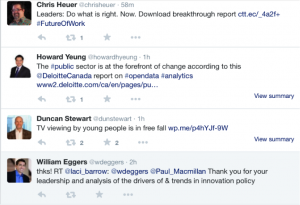I recently spoke at the Social Media Risk Reputation forum in Sydney where one of the most frequently asked questions was how to manage the blurring of professional and personal brand. Specifically, many delegates wanted to know if they should ‘allow’ C-suites or internal experts to engage on platforms and if so, whether to do so from personal or corporate accounts. It’s good that people are considering these issues and although there are complexities (like establishing who owns your social media accounts), as with most business risks, they are manageable. However we can’t continue to apply the same ‘rules’ to dealing with overlap as we did in a pre-technological age.
The personal-professional
2.55 billion people use social media for multiple reasons. Being mobile means people are checking social profiles during work and work emails late at night on a combination of devices. Personal and professional have blurred. Because social media is about expression, managing the impact is not a simple case of what a business decides it will or won’t ‘allow’. For example US courts are considering whether a ‘like’ is a form of speech and therefore, if firing someone for liking content can violate a free speech right. Although the law is different in Australia Social Media and the Law author Patrick George says “social media blurs the boundaries of what can be considered conduct at work and conduct ‘after hours’ and frequently raises the question of whether conduct engaged in on social media is ‘in connection with’ an employee’s employment.” The reality is that being mobile and interconnected through global networks has significantly changed people’s behaviour, their expectations of where and how they hear from businesses and how we are found and perceived as professionals. Social changes things. And that means how we deal with blurring has to change too.
There are business benefits
There are significant business benefits to being online and engaged –
- Digitally mature businesses (social media is a part of this) are outperforming their peers by around 25%. (MIT Sloane& Capgemini, McKinsey, Forrester).
- Social media can increase productivity by 20 – 25%. (McKinsey) or even 30% (Microsoft).
- Social CEOs are considered are more trusted and considered innovative. (Weber Shandwick, IBM, Brandfog).
But leveraging this potential means a business has to be out there. Those connected businesses that are most effective build online communities based on personal relationships. People want to connect with people whether that’s on the other side of a meeting table, telephone or tweet. Impersonal corporate messaging doesn’t cut it anymore.
Why business needs a personal front
People trust friends and are influenced by their recommendations whether these are virtual or real life connections. That means the billions of conversations going on in social media networks matter. Having a real person with an authentic presence working for you is good for business. At the same time a business must ensure that the time and effort put into developing a network delivers returns. Amongst other things this means that digital assets stay with the business when a key person leaves.
Why you need a personal-professional brand
You also need to think about your career over the longer term. Let’s face it, you’re unlikely to work for the same employer all your life. Just as a business needs to maintain the brand equity it builds through networks, so too for you. The influence you develop online like any skill should be transferrable to future roles. You need to do this with your employer foremost in mind. You are being paid to deliver a service for them. Your online time must deliver returns to the business. So then how do you strike the right balance between being and building ‘you’ and representing the business?
There’s no ‘one’ way
There’s no single or right way to manage dual branding but you can consider: – Allowing employees to talk work on personal accounts – Building two accounts – Go it alone
1. Allow employees to talk work on personal accounts
With a strong social media policy in place you can encourage employees to talk directly about your organisation or share content that broadly relates to it from a personal account. This makes a lot of organisations nervous, but there are plenty of examples of companies that are doing it well. Deloitte for example has separate Twitter accounts for various services. It also has a list of its people using the platform. 
These people are out there talking about research or issues relating to the industry but are very human and also talk back. This makes them accessible. This approach creates a massive amplification effect. Instead of a social media team (if you’re lucky) creating a limited online presence the whole workforce becomes a social force.
This approach demonstrates high employer-employee trust but as many commentators have observed, it’s little different from letting someone loose on the phone. Yes the reach and speed of communication is greater, but employees are using similar skills to manage issues. The difference is there’s a person to connect to, rather than an impersonal brand.
For this to work, employees need to show a bit of personality and share others’ as well as their own content. Firebrand’s Carolyn Hyams suggests an 80/20 rule sharing others’ content most of the time and your own the rest.
2. Build two accounts
One of the easiest ways to manage dual branding is to run two accounts – one in a person’s name and one for work. For example, while Deloitte people have an active online presence, there are also ‘corporate’ accounts for various services. 
Should employers allow this? I say yes. Using a simple scheduling tool like Buffer allows you to post to different accounts with one click. You can choose to share on either or both, depending on what you are posting. In this way, you grow your personal and work brand simultaneously and with little more effort. It also creates a halo effect. This approach makes it easier when you move on because you leave the business in great shape and take a legacy with you.
3. Go it alone
If your work just won’t go social then you need to go it alone. There may be legitimate reasons some companies won’t go social. If there’s a genuine cultural misalignment, it’s understandable, but you may be surprised at the number of conservative businesses that have used social successfully, including in highly regulated or traditional industries. Sometimes playing the culture card is just a way deflect attention from lazy thinking. Challenging an existing mindset is difficult. But you have to think beyond your current role. Using scheduling tools like HootSuite, Buffer or Social Bro you can set up your account to schedule posts while you are at work and respond to them after hours. You want to create a constant online presence without cutting into work time. It’s good to explain scheduling to your boss if you’re doing this because you don’t want them to assume that a tweet you sent at 10 am was actually sent at 10am. Of course it goes without saying that you use good judgement and if there’s a social media policy in place, make sure you’re operating within it. Be the shining example of how it can work
. *****************************************************************************************************
Dionne Kasian-Lew is the author of The Social Executive – how to master social media and why it’s good for business (Wiley). Connect with her on LinkedIn, Twitter @dionnelew, email [email protected].
Latest.

The Key to Being Job-Ready is Being Resume-Ready
Job Seeker

Are Companies Taking Advantage Of Job Seekers In A Competitive Market?
Industry Trends, Hiring Insights, Job Seeker

How To Use The Amazing Power Of Gen AI To Transform CX
Technology, Video Resources





